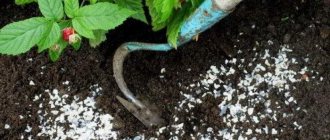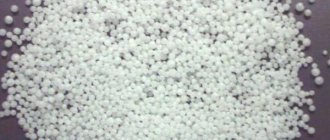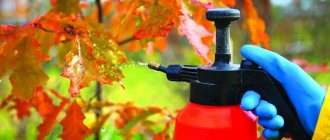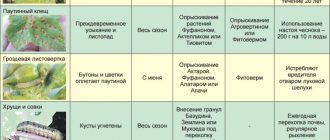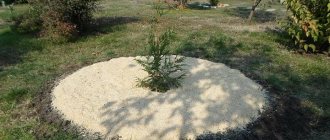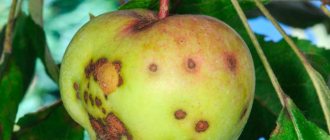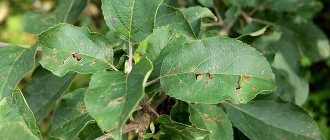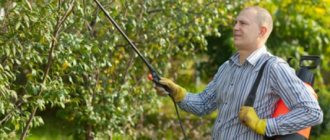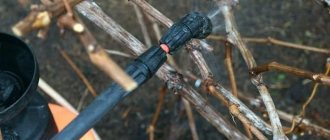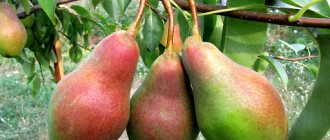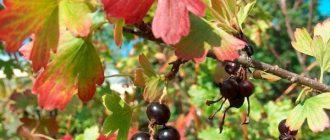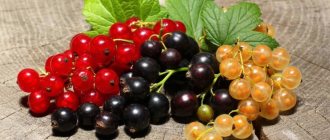Urea can be used to feed any crops: ornamental, fruit, and vegetable. The fertilizer contains ammonia nitrogen, which, rather than inorganic nitrogen salts, is absorbed in plant tissues, is intensively used in biochemical processes, and therefore its use is more effective than other nitrogen fertilizers. Among other beneficial properties, urea serves as an excellent preventive agent for the autumn treatment of apple trees against scab.
- How to use urea correctly
- Is it necessary to apply urea to planting vegetable and berry crops and how much?
- Feeding perennial flowers
- Feeding trees and shrubs
- Foliar feeding: why is it needed and how to do it correctly?
- Urea - as a means of protecting plants from diseases
- 5 Basic rules of application
Features of feeding trees and shrubs with urea
Fruit and berry and ornamental trees and shrubs are fed once or twice a season. Urea is applied over the entire crown projection, scattered over the surface before watering. When using organic fertilizers, the dose of urea is reduced by a third or even half. On average, from 150 to 250 g are applied to an adult fruit-bearing apple or pear tree, 100–140 g to a plum tree, and 30–40 g to a currant tree.
Fertilizing vegetable crops with urea: when used in dry form - 5–20 g per 1 m².
For cucumbers and peas, apply no more than 5–8 g/m² of dry urea,
For zucchini and squash add 10–15 g/m² of urea,
For tomatoes and peppers – up to 20 g/m² of urea.
For watering vegetable crops, you can prepare a solution: 20 g of urea per 10 liters of water. Water at the rate of 1 liter of the prepared solution per plant.
How to prepare the solution
The treatment of trees, flowers and crops in the garden, vegetable garden, and personal plot is carried out strictly according to the established standards for dissolving the substance in water. Below is the calculation of doses per 100 m2:
- For basic feeding, when it is planned to sow seeds for vegetables or plant seedlings, flowers, fruit and berry crops, you will need from 1.3 to 2 kg of urea. This dosage is suitable for applying to potatoes, garlic, tomatoes and cucumbers.
- To feed vegetable plants and flowers you will need from 0.300 to 0.400 kg of urea, and for berries and fruit crops - from 0.4 to 0.7 kg.
- To simply feed with a regular solution, you need to take 0.35-0.65 kg and dissolve it in 10 liters of water. This solution is distributed over an area of 10 m2.
- Foliar feeding in the garden or vegetable garden involves the use of urea solutions - 0.5-1%. To do this, it is necessary to dissolve from 0.05 to 0.1 kg of urea in 10 liters of water. This volume of solution is enough to treat an area of 100 to 200 m2. Plants or indoor flowers should be treated with a solution made from 1 liter of water and 5-10 grams of urea. For each bush or flower, no more than 15 ml of the substance should be used.
Foliar fertilizing with urea: why is it needed and how to do it correctly?
If there are signs of nitrogen starvation in plants, as well as in case of shedding of ovaries, it is useful to carry out foliar fertilizing with urea. Urea has an advantage over nitrate and other nitrogen fertilizers: it burns plant leaves less. The consumption of urea solution for foliar feeding is approximately 3 liters of working solution per 100 m².
The crowns of fruit trees are sprayed at a concentration of no more than 0.5% (50 g of urea per 10 liters of water). It is desirable that the urea solution in a fine-droplet state falls on both the upper and lower sides of the sheet, wetting it evenly.
For indoor plants, a urea solution for foliar feeding is prepared at the rate of 5–8 g of urea per 1 liter of water. If the plants have very pale leaves (which indicates a nitrogen deficiency), then 3 g of magnesium sulfate (magnesium sulfate) should be added to 1 liter of solution. The use of magnesium sulfate will reduce the risk of burns and increase the effectiveness of feeding, since magnesium is part of chlorophyll.
Foliar feeding is carried out in the morning or evening.
Characteristics of urea
It has the chemical formula CO(NO2)2 and has a molecular weight of 60.06 g/mol. Among other features of urea it is worth noting:
- Melts at 132.4 degrees Celsius.
- The specific heat capacity in water is 0.321 cal/gram*deg.
- The heat of fusion is 57.8 cal/gram.
- At temperatures above +80C, processes of water binding with the help of chemicals occur.
- At high temperatures, urea begins to transform into ammonium carbamate.
- At temperatures exceeding +130 degrees, urea breaks down into carbonic acid and ammonia.
Properties
The chemical has excellent qualities and capabilities, among which the following are worth noting:
- It easily dissolves in water, but is not washed out into the lower layers of the soil, which makes it possible to increase the effectiveness of the use of urea.
- High level of mobility and slow decomposition in soil.
- It does not have such a high oxidizing effect on the soil as ammonium sulfate.
- It has a positive effect on soils that have a lot of sand and clay.
- High level of nitrification in the ground.
- Productivity increases on lands that are regularly irrigated.
- Excellent for foliar feeding.
It should be noted that urea does not always bring the expected effect:
- In an alkaline environment, the substance breaks down into nitrogen and ammonia.
- Close contact of urea with sprouts will cause harmful effects of ammonia on the plant.
- Urea must be introduced into the soil on time, otherwise granulation processes will begin and biuret will form, which is dangerous for plants and trees. To prevent this from happening, it is necessary to add the substance to the ground one and a half to two weeks before sowing seeds or planting seedlings in the ground.
Urea - as a means of protecting plants from diseases
Urea can also be used to control pests and diseases.
When the first warm spring days arrive (average daily air temperature is +5 °C and above) before the buds begin to swell, a concentrated urea solution (500–700 g of urea and 50 g of copper sulfate per 10 liters of water) is used to spray fruit trees against pests, as well as from scab and other diseases.
Early spring spraying helps delay flowering and reduces the likelihood of damage to flowers by spring frosts in heat-loving crops (cherry plum, apricot and others).
In autumn, at the end of leaf fall (late October - early November), to protect apple trees from scab and other infectious diseases, spray the trees with a solution (500 g of urea per 10 liters of water). In principle, preventive treatment of trees with a urea solution can continue on all days when the air temperature is +5 °C or higher. It is also useful to treat fallen leaves. On young trees, before treatment, carry out a test spraying in advance and make sure that the concentration of the urea solution does not harm the bark or leave burns on it. For trees older than 6-10 years, carefully clean the places where the old bark has peeled off, heal cracks and fill up hollows.
In the photo: Treatment of plants with urea solution
Timing for spraying fruit trees
Autumn spraying should be done just before the onset of winter, when all the leaves have already fallen. Earlier treatment can lead to negative consequences, such as leaf burns and untimely leaf fall.
This will not only not bring a positive result, but will also lead to a weakening of the garden, which has not had time to receive all the nutrients and properly prepare for winter.
You need to start spraying in November, when there is no longer any danger of damaging the leaves with chemicals. Before starting treatment, you need to remove lichens and old bark from old trees with a metal brush.
Instructions for the use of urea or carbamide
When purchasing a sprayer, you need to pay attention to its volume and ease of use. It is advisable that the volume be no more than 10 liters, otherwise it will be difficult to carry it, and the cylinder fastening is like a backpack, which frees up your hands.
A homogeneous urea solution for spraying is poured into a sprayer bottle for spraying. The spray mode is set to finely dispersed in the form of dew.
Recommended Posts
Tree processing occurs from top to bottom. The crown, trunk and branches of the garden tree are carefully processed. At first it was synthesized from cattle urine by evaporation, the resulting substance was called urea. Urea is the scientific name for a chemical compound that is currently produced.
Why is urea used?
Due to its chemical properties, urea acts in several directions.
- The development of trees improves after foliar feeding with urea solution.
- Autumn treatment, when more than 40% of the foliage has fallen from the tree, helps strengthen the plant and its frost resistance. The solution is made the most concentrated: 8-10%.
- The vegetation of fruit trees after spring spraying slows down by about a week and a half. Delaying the flowering of varieties that ripen early makes it possible to avoid the threat of spring frosts.
- Urea prevents tree diseases such as scab, moniliosis, septoria, rot, cancer, and purple spot.
- Spraying with urea does not affect all pests, but it cleans the tree of weevils, apple blossom beetle, copperhead, aphids and some others.
- The bark is freed from moss.
- Small drops flow down the branches onto the soil, enriching it.
In the fall, urea is also sprayed on fallen leaves that cover the tree trunk.
Rules for working with urea
Preventive and therapeutic procedures are carried out based on general recommendations.
- When working with urea and copper sulfate, wear protective suits, goggles, and gloves.
- For processing from the beginning of spring, choose a warm, windless day.
- The entire tree, branches, buds or leaves are treated.
- The best results are achieved by spraying the entire garden. It's also worth talking to your neighbors to eliminate pests at the same time.
- Procedures are carried out in the morning or evening. This rule is strictly adhered to during flowering so as not to harm beneficial insects.
- It is advisable to check the weather forecast. Rain within 24 hours after treatment washes away the substance.
Urea will not protect against all diseases and pests, but the effect of cleansing the garden will be significant. In addition, the safety of the product should be taken into account. The use of urea will give a double result: protecting plants and fertilizing them.
Urea is amides of carbonic acid, which are colorless, odorless crystals. Among gardeners and gardeners, urea (urea) is often used as a universal, highly effective granular nitrogen fertilizer.
The use of urea promotes the development and growth of plants and their abundant fruiting. Urea as a fertilizer has proven itself excellent among amateur gardeners.
Treatment of plants with urea in the fall. Properties of nitrogen fertilizer
Urea refers to concentrated nitrogen compounds, which should not be confused with nitrate, which is harmful to the garden crown.
The composition is sold in the form of whitish granules without a pronounced odor. The crystals dissolve faster in water heated to +80°C, which makes it easier for the solution to be sprayed on the treated area. The hygroscopic composition should be stored in sealed boxes. Gardeners prefer spraying with urea in the fall not only for its 46% nitrogen concentration, but specifically for its intensive digestibility by garden crops that need to be saved from parasites. When working with urea in the fall, remember:
- Ureas are organic fertilizers, but their composition is determined by mineral nitrogen-containing components;
- This is a fast-acting concentrate whose properties last for a long period;
- the fertilizer quickly erodes, therefore it requires irrigation directly of the soil, including greenhouse and greenhouse soil;
- the connection is effective in waterlogged areas;
- biologically active soil retains more nitrogen than alkaline or neutral soil environments;
- nitrogen-containing fertilizers are more effective and safe for the garden in the autumn, when the foliage does not burn if the concentration is disturbed;
- urea slows down the growing season, delaying flowering from spring frosts that are fatal to the ovary. This will have a fruitful effect on the preservation of early ripening varieties of plum, peach and apricot, and the fruit trees themselves preserve the developing buds;
- after spraying in the fall, garden pests are killed, and various diseases of garden crops are eliminated;
- after combining with earth, urea turns into ammonium carbonate;
- nitrogen-containing compounds do not accept compounds with chalk, lime and simple superphosphates;
- urea helps get rid of old stumps, causing them to quickly rot;
- Autumn treatment of the garden with nitrogen concentrate protects garden plants from early frosts.
How to prepare a garden for spraying
Before spring treatment of the garden with urea and copper sulfate, it is necessary to prepare the trees:
- cut out dry and diseased branches;
- clean off areas of dead bark;
- coat the places of cuts and stripping;
- collect and burn last year's leaves.
All cleaned areas are disinfected with a solution of copper sulfate, and saw cuts - with garden pitch.
For this procedure, you need to choose a dry, windless day, when the air warms up to 5 degrees Celsius. In rainy weather, spraying will not be beneficial.
